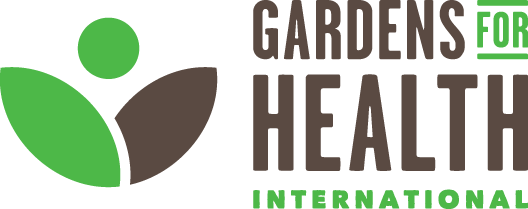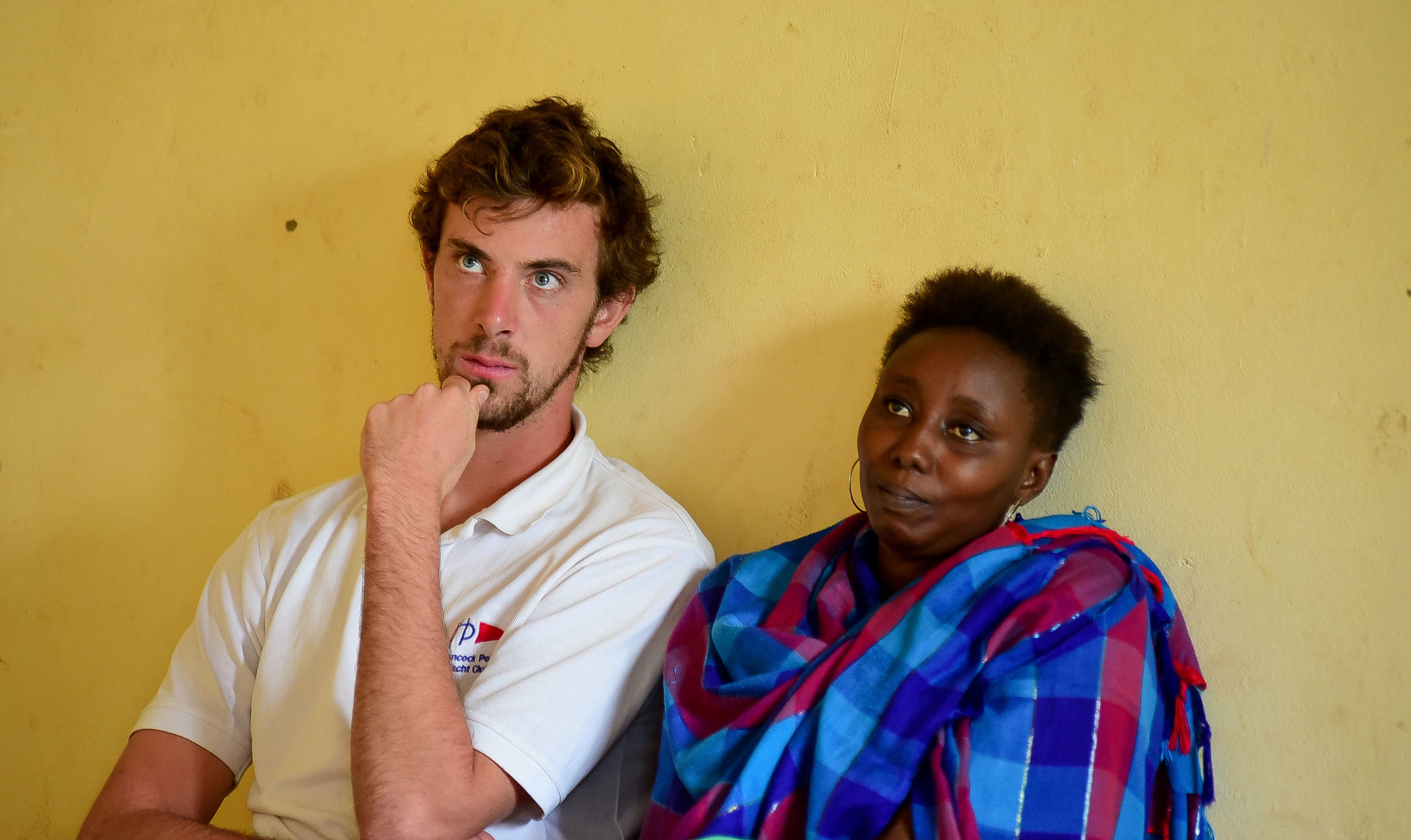Women's Empowerment Through Antenatal Care
POST BY JACK CUTLER, PHOTOS BY MAGGIE ANDRESEN // PUBLISHED DECEMBER 2017
Garden’s for Health’s Antenatal Care (ANC) Program plays an integral role in the comprehensive, long-term solution to chronic childhood malnutrition. The program focuses on preventing malnutrition in the first 1,000 days of a child’s life, from conception to age two, by equipping pregnant women with the knowledge necessary to raise healthy and thriving babies. The ANC Program, which began last August, teaches an abridged and adapted 6-week version of GHI’s Health Center Program trainings, with an emphasis on good practices for pregnant women. Topics of trainings include the importance of attending ANC health visits, how to shop for healthy food to create a balanced meal, the importance of good hygiene and water sanitation, good breastfeeding and complementary feeding practices, and postnatal care. A one-day “Father’s Day” seminar also provides an opportunity for partners to learn key topics covered in GHI trainings how to best support their wives through their pregnancies and beyond.
ANC participants listen during a nutrition training in Kayanga village.
As a short-term intern with GHI, I was privileged to attend an ANC training session with participants living in Kayanga, a small village nestled in the hills of the Gasabo district of Rwanda. The enthusiasm of the group was palpable even before entering the room, and could be heard from outside. About 20 women were actively engaged in the second weekly session and vigorously nodding as GHI field educator Come Blaise Kubwimana colorfully lectured to the room.
Field Educator Come Blaise Kubwinamana teaches GHI's four-color wheel of nutrition.
The lesson of the week taught the importance of cooking and eating a balanced diet by integrating GHI’s four color guide into every meal. The four colors are white, brown, orange and green. White foods are energy foods that include starchy carbohydrates like green bananas (ibitoke), rice, and Irish potatoes. Brown foods cover proteins and “strength foods” such as beans, eggs, and meats. The vitamin-filled orange foods are represented by fruits and certain vegetables like carrots, orange flesh sweet potatoes, and beets. Green foods are leafy green vegetables such as dodo, kale, swiss chard, and spinach and contain iron and other healthy vitamins and minerals. Foods falling into the brown and white categories are typically staples in the average Rwandese diet, although ensuring that green and orange foods are supplied presents more of a challenge. The lack of these foods contributes to the micronutrient discrepancies that can result in chronic malnutrition.
Food "for sale" during mock market exercise at Kayanga Health Center.
During the training, the field educator set up a mock-market exercise with a display of different foods while the women were given a budget of 800 Rwandan francs, approximately $1.00, to spend on their meal. The first woman to “shop” joyfully pretended to bargain and converse with the merchant. She purchased 200 francs worth of potatoes, 100 francs worth of salt, 100 francs worth of dodo, and 100 francs of isambaza, a popular local sardine, among other purchases, satisfying the brown, white, and green food group requirements. When the participant bought other foods to satisfy the orange food group she went over her budget. This restraint represents one of the biggest obstacles for future mothers trying to ensure a healthy diets for their children. While GHI can help educate mothers so they know what to buy and feed their children, their own purchasing power plays a significant role in the ability to to implement a diverse diet. The solution this participant thought of was to work on the merchant’s farm the following day to pay off her debt. Another commonly used solution that could help ease a mother’s financial restraint would be to start her own garden, where local grown greens such as dodo and kale could be harvested.
The author and Annonciathe Niyibizi, Health Coordinator, attend an ANC training at Kayanga Health Center in Gasabo District.
The women snacked on bananas and water as the Field Educators continued on to discuss “special vitamin” awareness, in order to insure that a child receives the appropriate amount of Vitamin A, Vitamin C, and Vitamin F. In between every few exercises, the group would break out in song, led by the GHI field educator. The beautiful voices of these future mothers harmonized with various hand-clapping patterns. This created a comfortable, fun and exciting environment for women to learn and engage. These strategies help ensure that lessons are taught effectively and the material is easily retainable.
Rwandese mothers are not always educated about basic nutrition concepts, including the components of a balanced meal, due to a lack of formal education. The ANC program helps fill this gap and sets families on the path to provide every opportunity for their children to grow, thrive, and succeed. After just over a year of conducting these trainings, GHI is already seeing significant gains, with requests from mothers and health center staff alike to continue with this work.
Donate today to support the ANC program and help more women eliminate malnutrition in their families and communities.
Translation by Monica Mutoni
--
Umwanditsi Jack Culter, Amafoto na Maggie Andresen
Gahunda y’umurima w’ubuzima ya ANC (yigisha abagore batwite) ifite akamaro kanini mu kuzana ibisubizo birambye ku mirire mibi. Iyi gahunda yibanda ku kurwanya imirire mibi mu bana mu minsi 1,0000 y’ubuzima bwabo, uhereye igihe umwana agisamwa kugeza ku myaka ibiri, abagore batwite bagahabwa ubumenyi bukenewe mu kurera abana babo bakagira ubuzima bwiza. Iyi gahunda ya ANC yatangiye mu kwa Munani k’umwaka ushize ikubiyemo amahugurwa y’ibyumweru 6 murima w’ubuzima utanga wibanda cyane ku bintu bitandukanye umugore utwite agomba kwitaho. Amwe mu masomo atangwa muri aya mahugurwa ni akamaro ko kitabira gahunda ya ANC abera ku bigo nderabuzima, uko wahitamo indyo ifite intungamubiri yuzuye, akamaro ko isuku no kunywa amazi meza, uko wakonsa umwana neza n’imfashabere. Umunsi w,babyeyi b’abagabo nawo ni amahirwe abagabo kuhabwa amahugurwa biga ukuntu bafasha abagore babo igihe batwite ndetse na nyuma yuko babyara.
Abitabira amahugurwa ya ANC bakurikirana amahugurwa muri Kayanga.
Nk’uwimenyereza umurimo mu murima w’ubuzima by’igihe gito, nagize amahirwe yo kwitabira amahugurwa ya ANC muri Kayanga harereye mu cyaro kiri mu misozi yo mu karere ka Gasabo. Amatsiko n’ubushake bwo kwiga by’abari bitabiriye amahugurwa byagaragariraga buri wese kandi wabyumviraga no hanze utarinjira mu cyumba amahugurwa atangirwamo. Abagore bagera kuri 20 nibo bari bitabiriye amahugurwa yo mu cyumweru cya 2 banyeganyezaga umutwe bagaraza ko bakurikiye ibyo uwigishaga Come Blaise Kubwimana yavugaga.
Utanga amahugurwa Come Blaise Kubwimana arimo gusobanura igishushanyo kigaragaza amabara ane y’ibiribwa.
Isomo ryatanzwe muri iki cyumweru ryari ryerekeye ku kamaro ko guteka no kurya indyo yuzuye ukoresheje uburyo bw’umurima w’ubuzima bwa’amabara ane muri buri funguro. Ayo mabara ane ni umweru, icyatsi, ikijuju na orange. Umweru urimo ibiribwa bitanga imbaraga bigizwe n’ibinyamafufu nk’ ibitoki,umuceri, n’ibirayi. Ibara ry’ikijuju rigizwe n’ibiribwa bitanga imbaraga nk’ibishyimbo, amagi, n’inyama. Ibiribwa bya orange byuzuye amavitamini bigizwe n’imbuto ndetse n’imboga z’amoko amwe namwe nka karoti, ibijumba bya orange na beterave. Ibara ry’icyatsi rigizwe n’imboga nka dodo n’ibindi bikungahaye ku myunyu ngugu, n’amoko atandakunye ya vitamini. Ibiribwa bisangwa mu ibara ry’ikijuju bikunze kuboneka cyane mu banyarwanda uretse ko kubona ibiribwa bisangwa mu mabara y’icyatsi n’ikijuju bidakunze kuboneka cyane bikaba bishobora gutuma habaho indyo ituzuye byatera kugwingira kw’igihe kirekire.
Ibiribwa bigurishwa byatangiwe urugero mu mahugurwa yabereye ku kigo nderabuzima cya kayanga.
Muri aya mahugurwa, uwigishaga yatanze urugero rw’ukuntu umuntu ahaha imyaka mu isoko akoresheje ibiribwa by’amoko atandukanye, abagore bahabwe bije ya 800Fr ahanye $1, ngo bayakorshe bahaha. Umugore wambere y’igize nkaho arimo guciririkanya ibiciro mu isoko. Yaguze ibirayi bya 200Fr, umunyu 100Fr, idodo 100Fr, isambaza 100Fr, ndetse n’ibindi bisangwa mu mabara y’ikijuju, icyatsi, umweru, na orange arenza ya 800Fr. Uru rugero rwagaragaje imbogamizi zikomeye abagore bazahura nazo mu gihe kiri imbere zo kubona indyo yuzuye y’abana babo. Mu gihe umurima w’ubuzima wigisha abagore kumenya ibyo bagaburira abana babo, ubushobozi bwabo bwo guhaha nibwo bubageza kuri iyi ndyo yuzuye. Igisubizo uyu mugore yatekereje nuko yazakora mu murima w’uyu mucuruzi kugira ngo azabone uko amwishyura amafaranga yamusigayemo.
Umwanditsi na Annonciata Niyibizi, umuhuzabikorwa w’ubuzoma bitabiriye amahugurwa ya ANC ku kigo nderabuzima cya Kayanga mu Karere ka Gasabo.
Ikindi gisubizo abandi benshi batekereje cy’ukuntu uyu mugore yakwishyura ideni rye ni uko yahinga umurima we akazajya yihingira imboga nka dodo n’izindi. Abagore bari bitabiriye amahugurwa bariye imineke banywa n’amazi mu gihe uwigishaga yakomeje kwigisha “ ni byiza kumenya vitamine zikwiriye kugirango abana bacu tubahe urugero rukwiye rwa Vitamine A, Vitamine C, na Vitamine F. Hagati y’iminota mike, abari bitabiriye amahugurwa bagiraga barya bagatera akaririmbo bayobowe n’uwigishaga. Amajwi meza y’abo babyeyi aherekejwe n’amashyi. Ubu buryo bufasha mu kugirango amasomo atangwe neza ndetse n’abiga bafate neza ibyo bigishwa.
Ababyeyi b’abanyarwanda akenshi baba bataragize amahirwe yo kwiga ibijyanye n’imirire myiza harimo ibigize indyo yuzuye kubera ko abenshi batagiye ku ishuri. Iyi gahunda ya ANC ifasha guha ababyeyi ubu bumenyi batari bafite ikanafasha imiryango kujya mu nzira yo guha amahirwe abana babo gukura neza bagatera imbere. Nyuma y’igihe kirenga umwaka umurima w’ubuzima utanga aya mahugurwa, hamaze kuboneka inyungu nyinshi ndetse ababyeyi benshi n’ubuyobozi bw’ibigonderabuzima bifuza gukomeza gukorana n’ibi bikorwa.
Byashyizwe mu Kinyarwanda na Monica Mutoni








